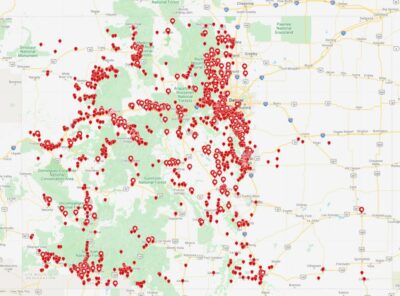Colorado Parks and Wildlife (CPW) received 3,701 reports of bear sightings and conflicts in 2021, a 28 percent decrease from the average number of reports in 2019 and 2020.
Weather and drought patterns in Colorado in spring, summer, and fall contributed to varied bear activity throughout the state. More than 90 percent of bears’ natural diet is made up of native grasses, berries, fruits, nuts, and plants, which are all dependent on moisture.
Adrian Archuleta, Area Wildlife Manager for CPW out of Durango, says that “good monsoonal summer moisture” is one of the biggest factors in the level of bear activity.
“In years where we get good moisture and the food mast is readily available and abundant, we don’t tend to have as many interactions and conflict,” he explains. “In years where it is very dry or we have a freeze event, a late frost, it can be very detrimental.”

A black bear sitting in a tree on Sept. 29, 2021 in a Littleton neighborhood just north of the S. Platte Canyon Rd. exit off of C-470 (Courtesy of Jason Clay/CPW.)
CPW’s northeast and southeast regions saw a large decrease in the number of bear reports. Winter, spring and early summer brought lots of moisture to the eastern side of the Continental Divide. There was a 39.8 percent decrease in bear calls from the average of the previous two years in the southeast, while the northeast region saw a 38.2 percent decrease.
The southwest also saw a major drop in bear reports (down 51.2 percent). However, bear reports were up from 2020 in the drought-stricken northwest, where bears were looking for both food and water.
CPW launched a new tracking system in 2019 to help wildlife managers track and quantify bear activity and conflicts throughout the state. This data helps to map trends and identify sources of conflict on localized, regional, and state levels.
Since its launch on April 1, 2019, CPW has recorded 14,013 sightings and conflicts with bears, nearly one-third of which were connected back to bears getting into the trash.

Map of bear activity in Colorado in 2021. Courtesy of CPW.
While bears getting into trash is the leading cause of conflict, other constant conflict sources include bird feeders, livestock, open garages, and other unsecured human-originated items. Kristin Cannon, Deputy Regional Manager for CPW’s Northeast Region, says these could all easily be reduced if the public takes some simple steps around their homes and properties to prevent bears from accessing them.
“We need help from local communities to develop strategies to secure garbage and other attractants across bear habitat,” said Kristin Cannon, Deputy Regional Manager for CPW’s Northeast region. “Ultimately, it will also require individuals to take some responsibility and follow proper guidelines on living appropriately with bears to protect them.”
CPW is also aware of the public’s potential reluctance to report bear activity over concerns that the bear will be put down. However, only 2.3 percent of the 14,013 bear reports wildlife managers received in the past three years have led to euthanization. Informing CPW when conflicts begin helps wildlife officers educate communities, make visits to homes to help secure attractants, and haze bears to help reinforce their natural fear of humans.
In specific cases, officers can attempt to relocate bears out of conflict areas to ease safety concerns or before the animal’s behavior escalates to a level that may require euthanization. CPW has relocated 213 bears from conflict sites in the past three years, but it is not a fix-all.
In recent years, relocation and euthanization numbers have fluctuated:
2021: 66 euthanized, 51 relocated
2020: 158 euthanized, 118 relocated
2019: 101 euthanized, 44 relocated
2018: 79 euthanized, 24 relocated
2017: 190 euthanized, 109 relocated
2016: 66 euthanized, 16 relocated
2015: 115 euthanized, 40 relocated
These figures are based on reports reviewed by CPW on April 1 each year, so 2021’s numbers could change if new data is confirmed.
Wildlife managers estimate there are between 17,000-20,000 bears in Colorado and that their population is stable and growing. Colorado has only black bears, but they can come in brown, blonde, and cinnamon colors, not just black.
To learn more about bears and how to reduce conflicts, visit the CPW website.







Recent Comments